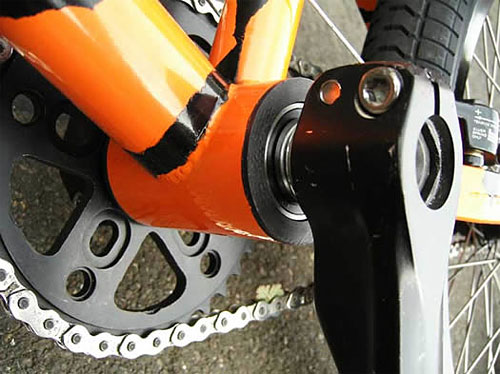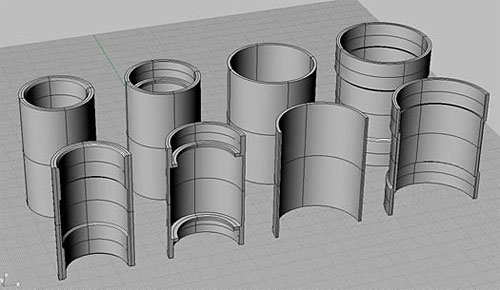Bottom Brackets AGAIN!!!
Once again I find myself writing about bottom brackets. Bollocks. I really don’t want to get labelled as some kind of obsessive dude who only thinks about bottom brackets all day long, yet I don’t seem to have much choice in the matter either.
Equally, I imagine that you -the noble reader- is pretty bored reading about them, but you too have little choice but to think about it. If you are in the market for a new frame anytime soon then you will HAVE to choose a bottom bracket. Most frames still come with a USA BB if you just want something you know works (even if it is a bit of a pain to fit sometimes), but most also now come with the option of a euro, some frames only come with a euro and some of the new ones to be launched over the next 12 months will only come with a Spanish or other BB shell.
Once you choose your frame then you are locked in. There is no switching BB size without switching frames or some major re-modelling….
While this is a pain for you it is even more of a headache for frame manufacturers. Imagine you make frames. Maybe you make 3 models in 2 top tube lengths each and 3 colour options for each. That’s 18 different frames to keep in stock (3x2x3) and if you have sold out of blue in one design the chances are you can talk a customer into taking a black one instead.
But now you also have to offer a euro BB shell as well as the USA version, so you have 36 frames to stock (18×2) and if the spanish BB takes off maybe you have to do that too so you end up with 54 different frame designs and you need to predict how many of each the public will want to buy !!! Get it wrong and you could end up with loads of frames that nobody wants and none of the ones they do…
For this reason, there ended up being a meeting of industry types at the subdivision show, with the single aim of thrashing out a new standard. Unfortunately it soon became evident that there is no simple solution in sight.
The main problem boils down to the conflict between metric and imperial crank designs.
A lot of people are running Profile or similar splined cranks. These normally use a ¾” axle which runs in imperial size bearings. To fit these into a USA or Euro BB you have a cup sized to fit and off you go.
BUT we aren’t ALL running these cranks, a similarly large number of people need the greater strength of a bigger axle so there are a lot of Primo cranks out there using a metric 22mm axle and metric bearings, as long as we use a cup of some sort then they can be made to fit in a USA or euro (though there isnt much room left for the actual bearings in the euro).
To add to the confusion we also have some 20mm axled cranks as well as 7/8” and 1” offerings from Profile and Solid respectively.
Fly’s Spanish BB will eliminate the need for a cup by pressing a bearing directly into the frame. But what size bearing should they use? Metric bearings tend to be cheaper than Imperial ones (except in the US) because they are more common, so that is what they have gone with. But for some bizarre reason they haven’t used the existing standard metric size bearing from the USA Primo BB, instead they have adapted a smaller bearing to fit.
The Spanish BB therefore ends up needing custom bearings to run ANY of the popular cranks. They plan on making 2 special size bearings; ¾” and 22mm, which will accommodate Profile race and Primo cranks but if you run 7/8” Profile SS or 1” Solids then you are out in the cold. The only off-the-shelf bearing that will fit is the one to take a 20mm crank axle.
So back to the meeting;
In FBM’s meeting room at Binghampton we all tried and failed to find a simple solution to this problem that anyone could agree on. Fly are a long way down the road of putting their design into full production, so not surprisingly they have no intention of turning back now. Lots of manufacturers are waiting to see how things will pan out; Will the Spanish BB end up needing some sort of reaming after welding to restore the shape? Fly say that the BB shell doesn’t distort at all after welding, if so that makes it a first in the history of engineering and they will have a big queue of motorbike manufacturers asking them how they do it. (Motorbikes use bearings that press directly into the frame, but all these seats are machined AFTER the frame is welded on big fancy machines that cost a lot of money).
We the People are just one example of a major company with doubts over the ability of the frame makers to keep all the production frames as undistorted as Fly claim their prototypes were…
Haro are ploughing on with the Truvative Oversize design mentioned last month. This is like the original photos we saw of the first Spanish BB prototypes when they were using a thread in cup like a giant euro BB. (Ride #72, page 34). By making different cups to fit normal bearings this should be able to cope with most cranks but all the problems that can occur with the euro are still there only your local bike shop wont have the tools to fix them….
FBM were playing it very coy with their own press-fit BB shell. (Theirs simply takes the existing imperial bearings that come with Profiles and if you run any other cranks they wont fit). At the time they insisted it was just an experiment but there was a lot of interest…
S+M seem to be the quietest on this front. As strong proponents of the integrated headset it seems likely that they will try something along the press-fit lines but not surprisingly they are keeping the details to themselves.
So how did the meeting go? Well it was fun and everybody had a laugh but if anything it just highlighted that the “problem” is only going to get much much worse before it gets better….
What is nice to see is that most of these new designs are being offered to the world FREE. There is no exclusive licensing deal (like there is with the “aheadset”), if you want to start making frames with the Spanish BB then you can. You don’t need permission and you don’t have to pay Fly a penny in royalties.
Yorkshire Bottom Bracket

Frame manufacturers HATE bottom brackets. They are an expensive part that needs to be machined accurately to size, they contribute quite a bit to the weight of the frame and in the case of the euro it has to be welded in the right way round and the threads protected during painting and shipping. And they need to do several types to suit all tastes/trends.
This (as much as user dissatisfaction) is why they want a new solution.
Last month I touched on an alternative, using plastic BB cups in a normal American bottom bracket to allow for dodgey fits and distorted shells. Now I have taken the concept a little further and created the Yorkshire bottom bracket.
The Yorkshire bottom bracket needs no precise machining and can be welded into the frame either way round. It is lighter than an American or Euro BB shell and less than 10% heavier than the proposed Spanish BB shell. BUT it is also massively cheaper than any of the others to make, and will accommodate any current crank bearing (with the right cups).
The Yorkshire BB is just a piece of 2” 16gauge tube 66mm long. That’s all.
Because the tube is totally un-modified the tolerance is very accurate without needing any precise machining work. Any welding distortion is taken up by the plastic cups which are themselves ludicrously cheap to make.
Innovative bike companies like Solid, Tree, G-Sport and others who have expressed an interest in bigger lighter hollow crank axles would have plenty of freedom to pick their own bearing size from any catalogue rather than having to fit in round a couple of restrictive custom ones….

Bottom Bracket Key.
Left to Right:-
Euro, Spanish, Yorkshire, USA.
Euro.
Threaded, left and right handed threads in right and left sides respectively. Inside diameter is approx 34mm so the biggest bearing you can get in there is about 32mm.
Outside diameter 40mm.
Typical bearing load capacity 4000Newtons each. Usually fitted with 2 bearings per side. Total theoretical load capacity 16kN.*
Typical weight of shell, cups and bearings:- 280g / 10ounces
Spanish
Internal shoulders. Symetrical side to side.
Inside bearing seat diameter 37mm.
Outside diameter 42mm.
Typical bearing load capacity 6400Newtons each. Total theoretical load capacity 12.8kN.
Typical weight of shell and bearings:- 180g / 6.4ounces
Yorkshire
Just a tube.
Inside diameter 47.6mm.
Outside diameter 50.8mm
Typical bearing load capacity 9400Newtons. Total theoretical load capacity 18.8kN.
Typical weight of shell, cups and bearings:- 300g / 10.6ounces
USA
Usually machined but no shoulders.
Inside diameter 51.2-51.4 ?!?!
Outside diameter 56mm
Typical bearing load capacity 9400Newtons. Total theoretical load capacity 18.8kN.
Typical weight of shell, cups and bearings:- 380g / 13.4ounces
* from this figure you would think that the euro wins hands down on strength to weight, but this figure is for radial (downwards) load. The euro hits problems when you load it from the end (axially) ie. landing a tailwhip or twist or dropping the bike on the pedal…
Since this article appeared in the September issue of Ride UK several new BB sizes have been launched. Most notably the new FBM midsize BB mentioned above HAS been made available and is already selling well. As mentioned it will not accept current bearings to take Primo or other 22mm axled cranks but Haro/Premium are looking closely at it and are making noises about producing custom bearing to do the job…
